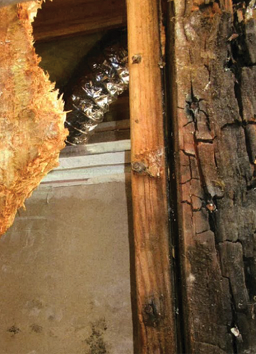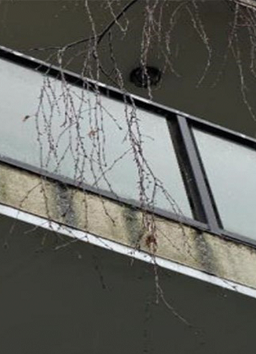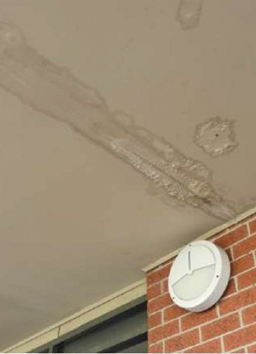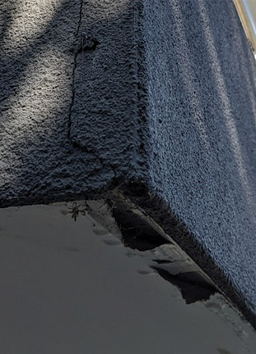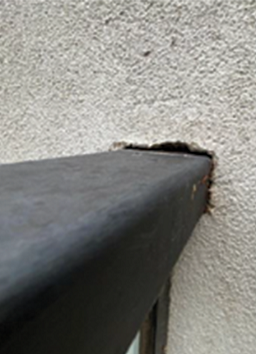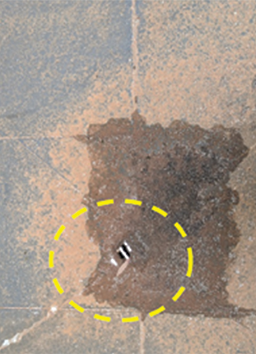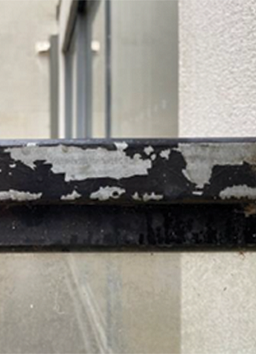Water ingress – balconies, decks and terraces
Water ingress in balconies, decks and terraces has been increasingly observed in Victorian residential buildings. The VBA performs, on average, 12,000 inspections of buildings under construction yearly, and waterproofing and weatherproofing continue to be areas of high compliance risk in inspected domestic and commercial building sites. Water damage routinely tops the list of defects encountered in buildings and in complaints to the Victorian Building Authority (VBA) and claims to the Victorian Managed Insurance Agency (VMIA).
The VBA partnered with VMIA and Victoria University to conduct research on indoor mould and moisture damage in Victorian residential buildings. The research examined VMIA accepted claims against domestic building insurance overlaid with building permit information from the VBA, to better understand the scope and causes of indoor mould in residential buildings and to identify opportunities for improvement. The research noted the occurrences of non-compliant design, construction and waterproofing of balconies is likely to lead to water ingress. Insights from the research identify improvement opportunities for building design, construction, inspection and improved guidance for waterproofing.
What is water ingress?
Water ingress is when water makes its way into a building. It can occur for various reasons and in different ways, leading to immediate damage or slow deterioration of building elements. If left untreated, it may lead to severe structural damage and expensive repairs, or health issues from mould growth.
| Image 1: The degradation of the structural timber frame caused by water ingress. |
| Image 2: Bottom plate of timber framed balustrade showing extensive water damage. |
| Image 3: Visible black mould as a consequence of water ingress into the wall cavity. |
| Image 4: The deterioration of the balcony structure is attributed to water ingress. |
Homeowners, tenants, and property owners should regularly check for signs of water ingress or damage and maintain their balconies, decks, and terraces. If not checked or maintained regularly, the consequences potentially pose serious safety and health risks. Generally, the longer water ingress is left untreated the greater damage may occur and rectification costs increase.
How do I know if I have water ingress?
Indicators of water ingress may appear on the same floor as the balcony, deck or terrace or be visible from the level below. Some warning signs that you should look out for include:
- Water marks seen on exterior walls, ceiling linings or structure
- Efflorescence in concrete or render (white mineral salts that leach from concrete with moisture and crystallise on drying)
- Cracked or discoloured concrete
- Creaky floors or damaged flooring or carpets, particularly near exterior walls and wet areas
- Movement in floor tiles or cracked grout (or tile tenting)
- Loose or rusted balustrade fixings or connections
- Damp patches, mould, stains, or discoloration on walls or ceilings
- Peeling paintwork, damaged paint, or peeling wallpaper
- Damp and musty smells
- Wetness in cabinets
- Swollen or cracked timber or plasterboard elements
- Soft, spongy timber which may indicate wood rot
- Rust stains or corrosion to metal
- Water ponding (the pooling of water that neither drains nor evaporates in a reasonable amount of time) which indicates inadequate fall and/or drainage and increases the potential of water damage
| Image 5: Rust on the steel balustrade implies that the steel may not have received the necessary protective treatment. |
| Image 6: Water marks on the exterior walls might be an indication of problems such as a blocked balcony drain, inadequate falls, or improper capping. |
| Image 7: Water marks and surface spalling are indicative of water ingress. |
| Image 8: Cracks in the facade finish and peeled paint may be indicative of the presence of moisture. |
What are the causes of water ingress associated with balconies?
Water ingress from balconies could happen for various reasons, including:
- Poor design, construction or maintenance of waterproofing systems
- Inadequate water diversion measures such as drains, overflows, and falls towards the drains
- Shedding of stormwater towards, rather than away from, the building
- Inadequate treatment or waterproofing of materials and connections
- Absence of flashing at balcony connection to the building
- Drying and cracking of short-life sealants (lack of maintenance)
- Inadequately sealed penetrations such as for balustrades, lighting and other services such as air conditioners
- Uncontrolled discharge from the air conditioner (lack of tundish drain)
- Use of inappropriate materials that are not suitable for external use
- Lack of maintenance and blockage of the balcony drains and/or overflows.
- Decline of material performance over time due to lack of protection/ maintenance (e.g. rusted fixings or steel balustrade)
What should I do to protect my property from water ingress?
All homeowners and commercial property owners with balconies, decks, and terraces should regularly inspect them for signs of leaks, damage, or deterioration. Every year, you should do a visual inspection.
If you spot any of the above water ingress signs or indicators, the VBA recommends that you engage a registered builder or a structural engineer to provide you with professional advice on the required rectification, as required. Engage a licenced plumber if you notice that the balcony outlet does not discharge completely or is slow to discharge after rain, as this may indicate outlet or drainpipe blockage.
| Image 9: Any unsealed penetrations that are visible should be dealt with promptly |
| Image 10: Check that balcony drains and overflows are unblocked, clean and functioning at full capacity to prevent any problems. |
| Image 11: To prevent rust, it's important to provide steel balustrades, posts and connections with an anti-rust coating and inspect them regularly. |
You may also seek the advice of leak detection companies that offer non-invasive technology to detect leaks without disturbing your balcony, enabling you to address the underlying issues. Once the reason for the water ingress is confirmed, you should take steps to address the cause to stop the water ingress as soon as possible to limit the extent of damage. This may not require costly repairs – sometimes it just a matter of painting steel balustrades or posts with an anti-rust protective coating and inspecting them regularly. The VBA website offers valuable information and guidelines for engaging a builder and engaging a plumber.
Additional safety measures for owners to check their balconies, decks, and balustrades can be found on the VBA website.
The Victorian Building Authority (VBA) continues to take proactive measures to improve building compliance and performance and eliminate water damage caused by water ingress on balconies. These measures include target audits and inspections, Practitioner Education Series webinars, consumer awareness media releases, and research-focused programs.

